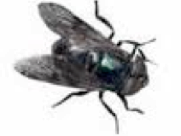
BLOG

I heard a Fly buzz - when I died
Emily Dickinson is so much smarter and more sensitive and more innovative and bolder in her writing than almost any one I’ve read. Bold? I know she was famous for being shy, but she wasn’t afraid of ideas. Her skepticism about even the fundamentals of Christianity still astounds me.
Sunday, August 21, 2011
I heard a Fly buzz –
when I died
BY EMILY DICKINSON
I heard a Fly buzz – when I died –
The Stillness in the Room
Was like the Stillness in the Air –
Between the Heaves of Storm –
The Eyes around – had wrung them dry –
And Breaths were gathering firm
For that last Onset – when the King
Be witnessed – in the Room –
I willed my Keepsakes – Signed away
What portion of me be
Assignable – and then it was
There interposed a Fly –
With Blue – uncertain – stumbling Buzz –
Between the light – and me –
And then the Windows failed – and then
I could not see to see –
Duh, how could she write a poem if she died? Good question, Albert. She’s adopting a persona, pretending she’s somebody else, to explore what is the most important moment to religious people - the moment when you find out if all the talk about God and heaven has been legit - the moment when you see the afterlife.
Note that all the nouns in this stanza are capitalized. like Germans do it. But looking further, you see that some nouns aren’t, like “portion” and “light,” and some adjectives and verbs are. So what is Dickinson doing? She’s showing us how to read the poem aloud, what to emphasize. The dashes work the same way, telling us when to pause.
Flies are annoying and insignificant, but they buzz. Buzzing has been a slang term for spreading gossip since at least Shakespeare’s time. (Hamlet uses it.) So when the speaker is ready to hear or see the big revelation, a fly comes around and spoils the stillness and portent of the moment.
Pretty cool to call crying people “Eyes” and sobbing people “Breaths,” hey? The technique is called synechdoche - the using of a part to represent the whole.
“Onset” is great because it can mean three things...tears, the beginning of something, or an attack. All three work for a death bed scene, especially a Christian one, where death is the beginning of the afterlife.
Note that the importance of the speaker’s death is that the onlookers, and the dying person, expect to experience God, “the King.”
The dying person is divesting herself of all her worldly goods. I guess certain portions of her would not be “Assignable,” like her intellect, her emotions, etc. Those things are left behind, but one can’t give them away. Anyhow, now she’s all ready to see Paradise and her comes this dad-burned Fly!
How can a Buzz be Blue? That’s another cool technique, synesthesia, the mixing of two senses. The fly is a symbol for the nagging uncertainty that Dickinson felt about the afterlife. (See, “Because I could not stop for death...”)
The light has multiple meanings, like actual physical light, understanding, or God himself.
The windows have at least two meanings. There are the actual windows in the room and then her eyes, the windows to the soul.
See has multiple meanings... to get a glimpse of, to understand...
See how complex she is? Dickinson is shaking us and demanding, “How can you all be so sure? How do you know we’ll understand the afterlife? We don’t understand life!” There’s a psychological phenomenon called the “Dunning-Kruger Effect.” It states that inexperienced, incompetent people are the ones who are often confident while experts aren’t so sure. (Just think about how kids who assert, “That test was easy,” are usually the ones who get 71%) When it comes to Death, we are all inexperienced. How the heck can we say what happens after?
